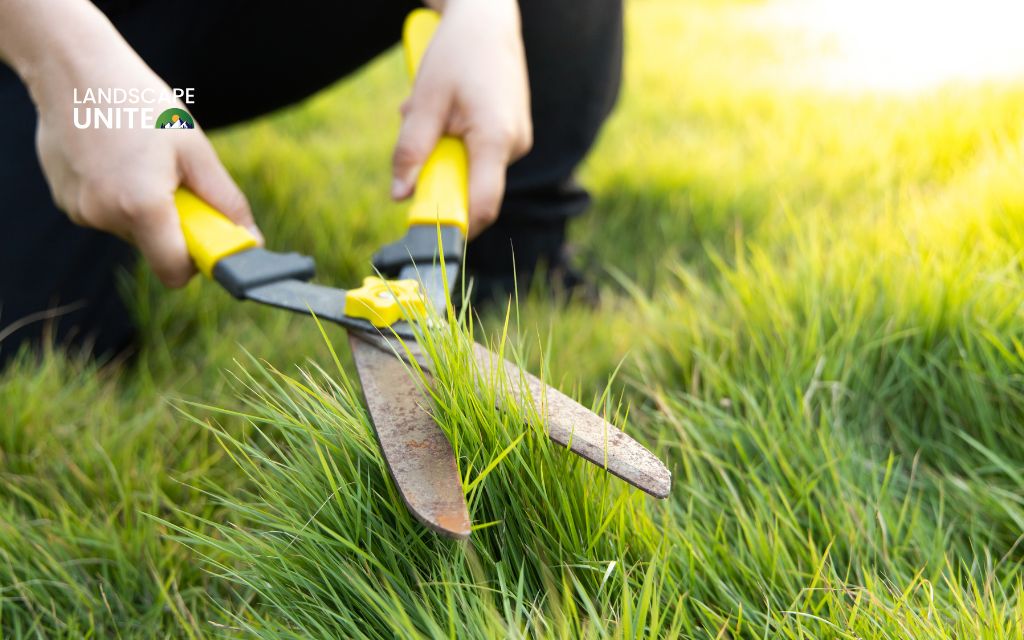The science behind mowing height is straightforward yet crucial: grass blades function as solar panels, capturing sunlight to fuel root development and overall plant health.
Cut too short, and you’re starving your lawn while exposing it to stresses. Allow it to grow too tall, and you risk creating conditions that harbor pests, diseases.
Whether you’re dealing with scorching summer heat or preparing for winter dormancy, understanding proper practices can mean the difference between a lush, enviable lawn and one plagued by weeds, disease, and bare patches.
Keep reading below to discover the complete seasonal mowing height strategy that will give you the lush, healthy lawn you’ve always wanted.
General mowing height guidelines by season
Different grass types respond uniquely to seasonal changes, requiring tailored approaches for optimal health and appearance.
| Season | Cool-Season Grasses | Warm-Season Grasses |
| Spring | 2.5 – 3 inches | 1 – 1.5 inches |
| Summer | 3 – 4 inches | 1.5 – 2.5 inches |
| Fall | 2.5 – 3 inches | 1.5 – 2 inches |
These recommended ranges account for the natural growth patterns and stress tolerance characteristics inherent to different grass species.
Cool-season varieties like tall fescue and Kentucky bluegrass perform best with higher cutting heights, while warm-season grasses such as Bermuda and Zoysia maintain their health and density with shorter cuts.

What mowing height should you mow in spring?
Spring marks the awakening of your lawn from winter dormancy, making proper mowing height critical for establishing strong growth patterns throughout the growing season.
Cool-season grass
For cool-season grasses including tall fescue, Kentucky bluegrass, and perennial ryegrass, begin mowing at 2.5 to 3 inches once active growth resumes.
This height range serves multiple purposes: it helps suppress early-season weed germination by shading the soil surface, encourages dense turf development, and provides adequate leaf surface for photosynthesis after months of dormancy.
Warm-season grass
Warm-season grasses like Bermuda grass and St. Augustine require a different approach. Begin mowing when the grass shows signs of greening up, typically maintaining a height of 1 to 1.5 inches. The key principle here is gradual reduction rather than dramatic scalping.
Zoysia mowing height in spring should start slightly higher at 1.5 inches, then gradually reduce as the grass fully emerges from dormancy.
What mowing height should you mow in summer?
Summer presents the greatest challenge for lawn health, with intense heat, drought conditions, and peak growth periods demanding strategic mowing height adjustments.
Cool-season grass
During summer months, raise your mower deck to maintain 3 to 4 inches for cool-season grasses. This increased height serves as natural insulation, shading the soil surface and root zone while reducing water evaporation.
Tall fescue mowing height should remain at the upper end of this range (closer to 4 inches). Kentucky bluegrass can fluctuate between 3 to 3.5 inches, depending on local climate conditions and irrigation availability.
Warm-season grass
Maintain cutting heights between 1.5 to 2.5 inches, with specific adjustments based on grass type and local conditions.
- Bermuda grass should range from 1.5 to 2 inches, taking advantage of its aggressive growth habit while maintaining density.
- St. Augustine works best at 2 to 2.5 inches, accommodating its broader leaf structure and shade tolerance.
- For Zoysia, aim for 1.5 to 2 inches to balance density with stress tolerance.
What mowing height should you mow in fall?
Fall mowing height decisions directly impact your lawn’s winter survival and spring recovery. This season requires a delicate balance between preparing for dormancy and maintaining adequate protection.
Cool-season grass
As temperatures begin to cool, gradually lower your cool-season grasses back to 2.5 to 3 inches. This recommended lawn mowing height encourages root development during the fall growing season while preparing the turf for winter dormancy.
- Tall fescue should stabilize at 3 inches, providing adequate crown protection while preventing matting under snow cover.
- Kentucky bluegrass can be reduced to 2.5 inches, taking advantage of its natural cold tolerance and growth patterns.
Warm-season fall preparation
Warm-season grasses require more dramatic height adjustments as they prepare for dormancy. Gradually reduce cutting heights to 1.5 to 2 inches as growth slows and temperatures drop.
- Fall mowing height for Bermuda grass should target 1.5 inches, helping prevent thatch buildup and reducing fungal disease risk during dormancy.
- St. Augustine can remain slightly higher at 2 inches due to its less aggressive growth habit and different dormancy characteristics.
[What mowing height should you mow in fall?]
How to prepare your lawn for winter
Final cut
Your final mowing session should occur when grass growth significantly slows but before complete dormancy.
Leave grass at the recommended fall heights to provide insulation for crowns and root systems while preventing excessive matting that can harbor diseases.
Clear grass clippings after this final cut, or ensure they’re chopped finely enough to decompose quickly. Heavy clipping layers can create anaerobic conditions that promote fungal diseases during winter months.
Debris management
Weekly leaf removal becomes critical during fall months. Accumulated leaves can suffocate grass, create moisture retention problems, and provide overwintering habitat for pests and diseases.
Either rake leaves or mulch them finely enough to filter down through the grass canopy.
Nutritional support and overseeding
Apply winterizer fertilizer 6 to 8 weeks before expected ground freeze. Choose formulations high in potassium, which strengthens cell walls and improves cold tolerance.
Avoid high-nitrogen fertilizers that can stimulate late-season growth vulnerable to frost damage.
Address thin areas through fall overseeding, completing the process early enough for establishment before winter. New seedlings need 6 to 8 weeks of growing time to develop sufficient root systems for winter survival.
Why does mowing height matter?
Understanding why mowing height matters helps inform better decision-making throughout the growing season.
Grass plants follow predictable physiological responses to cutting height that directly impact lawn health and appearance.
Root-to-shoot relationships
Research consistently demonstrates strong correlations between cutting height and root development. Grass cut at proper heights maintains extensive root systems that improve drought tolerance, nutrient uptake, and overall plant vigor. Conversely, grass cut too short develops shallow root systems that struggle during stress periods.

Competitive advantage against weeds
Proper height creates competitive advantages against weeds through multiple mechanisms. Taller grass shades the soil surface, preventing weed seed germination. Dense turf grown at appropriate heights also outcompetes weeds for nutrients, water, and growing space.
Disease and pest resistance
Grass maintained at proper heights shows improved resistance to common lawn diseases and pest problems. Adequate leaf surface supports strong immune responses, while proper air circulation reduces fungal disease pressure.
Conclusion
Mastering proper mowing height throughout the seasons represents one of the most impactful decisions you can make for your lawn’s long-term health and appearance.
By understanding the specific needs of your grass type and adjusting cutting heights to match seasonal growth patterns and stress factors, you create the foundation for a resilient, beautiful lawn that enhances your property value and outdoor enjoyment.
Remember that lawn care is a marathon, not a sprint.
Consistent application of proper principles, combined with appropriate timing and technique, will deliver the healthy, attractive lawn you desire while reducing long-term maintenance requirements and costs.
Learn more about complete lawn care strategy in our extensive lawn care resource center, where you’ll find expert resources covering everything from soil health to pest management.
Frequently asked questions (FAQs)
How do I know if I have cool- or warm-season grass?
Cool-season grasses thrive in northern climates and include fescue, bluegrass, and ryegrass varieties. They grow actively during spring and fall with summer dormancy periods. Warm-season grasses dominate southern regions and include Bermuda, Zoysia, and St. Augustine varieties that grow actively during summer months.
Should mowing height remain constant year-round?
No, seasonal adjustments are essential for optimal lawn health. Grass height should increase during stress periods (summer heat) and decrease during active growing seasons (spring and fall) to match plant physiology and environmental conditions.
Is it safe to mow dormant grass?
Avoid mowing completely dormant grass, as cutting can damage crowns and delay spring recovery. Wait until active growth resumes in spring, or complete final cuts before dormancy begins in fall.
Can I cut grass shorter in fall to reduce spring maintenance?
Slight height reductions are acceptable and beneficial in fall, but avoid excessive scalping that weakens the lawn and promotes disease problems. Follow recommended fall heights for your grass type.


